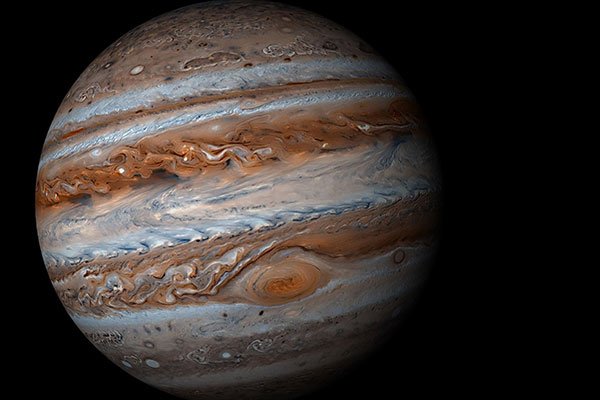(单词翻译:单击)
听力文本
This is Scientific American — 60-Second Science. I'm Lee Billings
Got a minute?
For most people, Jupiter's most recognizable—and mysterious—feature is the Great Red Spot. For centuries, astronomers have watched the storm spin across the giant world's face.
But for planetary scientists, Jupiter's most distinctive mystery may be what's called the "energy crisis" of its upper atmosphere: how do temperatures average about as warm as Earth's even though the enormous planet is more than fives times further away from the sun?
All the sun's giant planets display this energy crisis, and those in chilly orbits around other stars probably have it, too. So where does the energy to heat their upper atmospheres come from?
According to a new study, the energy must originate within the giants, get transported upward and become amplified by turbulent storms. The finding appears in the journal Nature.
This offers a new window into Jupiter's depths, and should allow researchers to better understand gas-giant atmospheres throughout the universe. And it's all connected to the Great Red Spot.

Astronomers have long known that auroral displays can heat Jupiter's poles, where charged particles trapped in the planet's intense magnetic field slam into its upper atmosphere. Some theorists thought this auroral heating could flow toward the equator to warm the planet's mid-latitudes. So, using NASA's Infrared Telescope Facility, astronomers observed Jupiter for nine hours, looking for these flows as thermal fluctuations in the planet's upper atmosphere.
But they saw none.
Instead, in Jupiter's mid-latitudes they spied a thermal spike 800 kilometers above the Great Red Spot, where temperatures soared hundreds of degrees higher than the surroundings. The best way to explain this spike is from the swirling maelstrom below, where turbulent atmospheric waves must generate heat by crashing together like breakers on a windy beach shore. Though this must be a planet-wide phenomenon, it is most obvious directly over Jupiter's largest, most powerful storm.
As alien as it seems, scientists have seen the same behavior on much smaller, gentler scales here on Earth, when thunderheads rising over mountain ranges create rippling waves that heat the air above.
Thanks for the minute for Scientific American — 60-Second Science Science. I'm Lee Billings.
参考译文
这里是科学美国人——60秒科学。我是李·比林斯。
有一分钟时间吗?
对大多数人来说,木星最容易辨认、最神秘的特征在于:大红斑。数个世纪以来,天文学家已经观察到了木星表面这一风暴气旋。
但是对行星科学家来说,木星最最独特的神秘之处在于所谓的上层大气中的“能源危机”:木星这颗巨大行星到太阳的距离比地球到太阳的距离远五倍以上,可是为什么其平均温度却和地球一样温暖?
所有太阳系中的巨行星都呈现出这种能源危机,而那些在寒冷轨道围绕其他恒星运转的行星可能也会出现这种能源危机。那么,使上层大气升温的能源从何而来?
一项新研究表明,这一能源肯定源自巨行星,然后向上输送,并通过猛烈的风暴扩大。该项研究结果发表在《自然》杂志上。
这为探索木星深处提供了一个新视角,并且这一发现使研究人员可以更好地了解整个宇宙中巨型大气层的奥秘。而这一切都与大红斑有关。
天文学家很早以前就知道极光可以使木星的两极升温,这是因为被困在木星强磁场中的带电粒子和其上层大气发生了猛烈撞击。一些理论家认为,这种极光加热可以向赤道流动,从而使木星中纬度地区变暖。所以,天文学家利用美国航空航天局的红外望远镜设备观测了木星9个小时,试图在木星上层大气发生热涨落时寻找这一热流。
但是他们什么都没看到。
相反,在木星的中纬度地区,他们在大红斑上方800公里处发现了温度峰值,相比于周围的温度,这个地方的温度飙升了几百度。对此最好的解释是这种温度飙升来自下方的漩涡,那里的大气湍流通过互相碰撞产生热量,就像在起风的沙滩上拍打海岸的白浪一样。虽然这是一种宇宙现象,但木星最强大的风暴使其尤为显著。
虽然看起来很奇怪,不过科学家已经在地球上发现了规模较小、较温和的相同现象,当雷雨云砧上升越过山脉,就会产生加热上方空气的微波。
谢谢大家收听科学美国人——60秒科学。我是我是李·比林斯。
译文为可可英语翻译,未经授权请勿转载!
重点讲解
重点讲解:
1. even though 即使;尽管;纵然;
例句:The book is a mirror of his life even though it is not a biography.
这本书虽然不是传记,但仍旧是他生活的写照。
2. come from 来自;始于;
例句:Correct ideas come from social practice.
正确的思想来自社会实践。
3. according to 依据,根据,依照;
例句:You've been in prison six times according to our records.
根据我们的记录,你曾入狱六次。
4. slam into 猛烈撞击;
例句:The plane slammed into the building after losing an engine shortly after take-off.
飞机起飞之后不久,就有一个引擎出现故障,随即便一头撞上了大楼。


